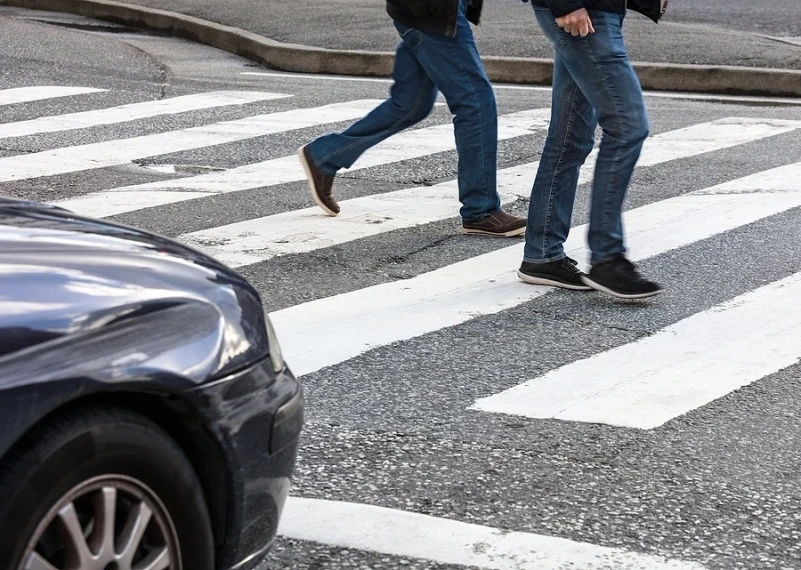Pedestrian Accident Lawyer Atlanta

Pedestrians struck by vehicles in Atlanta often suffer severe, life-changing injuries. Lampariello Law is here to help you pursue the compensation you deserve. Our experienced pedestrian accident lawyer knows how to handle complex liability issues and fight for your rights against negligent drivers and insurers. Whether you were hit at a crosswalk or in a parking lot, you shouldn’t bear the costs of someone else’s recklessness. Call Lampariello Law today at 404-609-0597 for a free consultation and speak with a pedestrian accident lawyer dedicated to your recovery.
Crosswalk Accidents: How Liability Is Determined in Georgia
Busy Atlanta streets see a constant mix of cars, trucks, bikes, scooters, and pedestrians. Intersections with crosswalks should provide safe passage for walkers, but collisions still happen. When a driver strikes a pedestrian in a crosswalk, questions about fault follow quickly. Georgia law offers clear ground rules, yet each crash has unique facts that influence liability.
Georgia Right-of-Way Basics
State statutes give pedestrians the right of way in a marked crosswalk when the signal favors them. Drivers must stop and remain stopped until the pedestrian reaches the far side or a safe zone on the road. If no traffic signal exists, drivers must yield once the pedestrian is on the roadway half of the driver’s lane.
Pedestrians, for their part, must obey traffic control devices. If the “Don’t Walk” symbol is steady or flashing, they should wait. Stepping off the curb against a red hand can cut into a claim for damages.
Modified Comparative Fault
Georgia follows a modified comparative negligence rule. An injured pedestrian can recover damages only if their share of fault is 50 percent or less. Any award is reduced by that percentage. For example, if a jury finds a walker 10 percent responsible for darting into the street before the walk signal, compensation drops by 10 percent.
Because insurers leverage comparative fault to reduce payouts, documenting driver negligence becomes critical.
Key Evidence Used to Establish Liability
- Police Report
Responding officers interview parties and witnesses, note skid marks, check traffic signals, and record weather conditions. Citations for speeding or failure to yield strengthen the pedestrian’s case. - Traffic Camera and Surveillance Footage
Downtown Atlanta intersections often have cameras. Videos show driver speed, lane position, and whether the pedestrian entered on a walk signal. - Vehicle Data
Some cars store event data recorder (EDR) information, capturing speed and brake use seconds before impact. Subpoenaing this data can confirm or contradict driver claims. - Eyewitness Statements
Passengers, other pedestrians, or nearby store employees may describe signal phases, horn warnings, or distracted-driver behavior. - Cell-Phone Records
Proving the driver texted or called at the moment of impact can tip liability decisively. - Scene Photos and Measurements
Crosswalk striping, lighting, and line-of-sight obstructions help experts reconstruct events.
Common Driver Negligence Factors
- Failure to yield despite a walk signal or flashing pedestrian beacon
- Speeding through intersections, reducing reaction time
- Right-turn conflicts, where drivers focus on traffic to the left and overlook walkers entering from the right
- Left-turn collisions when drivers misjudge pedestrian speed
- Distracted driving, including cell-phone use or infotainment systems
- Impaired driving due to alcohol, drugs, or drowsiness
If any of these factors contributed, driver liability becomes easier to establish.
Potential Pedestrian Negligence
Drivers often argue the pedestrian shared blame by:
- Entering the crosswalk against the signal
- Walking outside the marked lines
- Wearing dark clothing at night with poor visibility
- Suddenly running from behind a parked car or bus
Courts weigh these arguments carefully. Even if a walker made a mistake, a speeding or distracted driver may still bear the larger share of fault.
Unique Challenges at Mid-Block Crosswalks
Atlanta has mid-block crossings near MARTA stops and campus areas. Drivers sometimes overlook them, assuming pedestrians cross only at corners. Liability still falls on drivers who ignore signage and flashing beacons, but pedestrians must activate signals when present and ensure traffic stops before stepping out.
Injuries and Damages
Crosswalk collisions frequently cause:
- Traumatic brain injuries
- Spinal cord damage or paralysis
- Multiple fractures and orthopedic surgeries
- Internal organ injuries
- Severe road rash and scarring
Damages in a successful claim may cover emergency care, ongoing therapy, lost income, future earning capacity, and pain and suffering. Documenting each cost early helps prevent insurers from disputing medical necessity later.
Steps to Take After a Crosswalk Accident
- Seek Medical Attention
Call 911. Even minor aches can mask internal injuries. Immediate treatment also links injuries to the crash. - Gather Evidence if Able
Snap photos of the scene, traffic signals, vehicle position, and injuries. Get names and contacts of witnesses before they leave. - Request the Police Report
Obtain the report number at the scene and pick up the full document when available. - Preserve Clothing and Personal Items
Torn or blood-stained garments show impact points and injury severity. - Avoid Recorded Statements
Insurers may call quickly. Provide basic facts but decline recorded interviews until you speak with a lawyer. - Consult a Pedestrian Accident Attorney
An attorney can secure video footage, subpoena phone records, and retain reconstruction experts before evidence disappears.
Time Limits for Filing
Georgia’s statute of limitations generally allows two years from the accident date to file a personal-injury lawsuit. If the defendant is a city or state agency—for example, a MARTA bus driver—the filing window can shrink to six or twelve months for ante-litem notice. Missing a deadline usually ends the claim.
Role of Uninsured Motorist Coverage
Hit-and-run crosswalk accidents leave victims unsure who to sue. Georgia drivers may use their own uninsured motorist (UM) coverage to pay medical bills and other losses. Pedestrians often do not realize they can tap UM benefits on any household auto policy—even when walking. A lawyer can identify these hidden sources of recovery.
Comparative Fault Example
Imagine a pedestrian steps into an Atlanta crosswalk at dusk. The signal shows “Walk,” but the walker looks at a phone while crossing. A driver, speeding to beat a yellow light, hits the pedestrian. A jury might assign 15 percent fault to the walker for distraction and 85 percent to the driver for speeding and failure to yield. If total damages equal $200,000, the pedestrian would recover $170,000 (85 percent of the total).
Why Early Legal Help Matters
Evidence fades fast. Traffic-camera footage can overwrite within days. Skid marks wash away in rain. Witnesses forget details or move. A personal-injury attorney acts quickly to:
- Preserve digital and physical evidence
- Work with accident-reconstruction specialists
- Calculate current and future costs of medical care
- Negotiate assertively with insurers or litigate in court
Most firms work on contingency, meaning no upfront fees. This allows injured pedestrians to focus on healing while professionals handle the legal side.
Seek Fair Compensation with a Pedestrian Accident Attorney
Pedestrians struck by vehicles often face long recoveries and mounting expenses. Lampariello Law is here to help injured individuals in Atlanta get the justice they deserve. Our pedestrian accident attorney will thoroughly investigate your case, determine liability, and fight for full compensation. You shouldn’t have to pay the price for a driver’s negligence. With our firm on your side, you’ll have an advocate committed to your recovery. Call Lampariello Law at 404-609-0597 today for a free consultation with a trusted pedestrian accident attorney ready to defend your rights.
